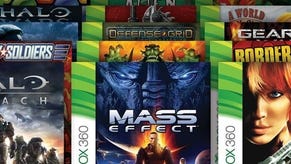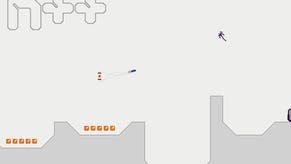N+
Consonant craving.
There's a secret Achievement in N+ that gives you 15 Gamerpoints for dying one thousand times. This detail is very important, as it rather neatly sums up the N+ experience: this is a game where you will die. A lot. The question isn't whether you'll unlock this Achievement, but when. The fact that you get Gamerpoints for repeated failure subtly tips you off that this is okay, is expected in fact, and also defines what makes the game's razor sharp design so damnably cunning - above all things, perseverance is always rewarded.
The nutshell, then. You control N, a minimalist yet acrobatic ninja figure. Before you lie more than 400 single-screen challenges, divided up into episodes of five levels. In each one you must hit a switch to open the exit, then leave. Complicating this simple task are countless sadistic obstacles, both environmental (lethal drops, explosive mines, perilous leaps) and aggressive (electrified drones, gun turrets, homing missiles).
You're constantly playing against the clock, with the same timer running throughout all five levels in each episode. Picking up gold pieces extends your time but, typically, these are often placed in harm's way. Progress becomes a balancing act between finding the fastest and/or safest route to the exit and ensuring that you add enough time on the clock to finish the remaining levels along the way. Much like the "reach the exit" gameplay, it's a beautifully simple mechanism that throws up dozens of quickfire quandaries with every jump.
Physics is of a semi-realistic ragdoll variety, with N able to perform gravity-defying leaps and ping-pong off walls, yet he's still bound by the general laws laid down by Mr Newton. Momentum and inertia are key factors to efficient play, as our stick-man hero is able to jump higher and farther provided he's moving fast enough. The sword cuts both ways though - hit the ground at the wrong velocity, regardless of distance, and N is splattered.

It's all rather fantastic, truth be told. There's immediacy in controlling N that makes navigating the levels a pleasure in itself, making every ludicrous leap a right old giggle, and this helps to take the edge off the high death toll. It's frustrating, of course, but only in that deliciously masochistic way that so many classic platformers manage.
The level design is actually impeccable and utterly fair - you soon come to realise that every flat surface, every slope, every hazard, has been placed precisely to make your life harder, or easier, depending on whether you've figured it out. There are puzzles here that will find you leaving tiny crescent-shaped teeth marks in your controller, swearing that you hate this game and will never play it again ever. Then you suddenly see the problem from a different angle, realise that you can jump up to there, wall-jump across to there, and hit the switch from up here, dropping down into the exit avoiding a cluster of mines that previously seemed impassable. And then you try it, and it works, and you swear that you love this game and it's the most addictive thing ever and you feel the warm rush of hard won vindication and then...the cycle starts again.






